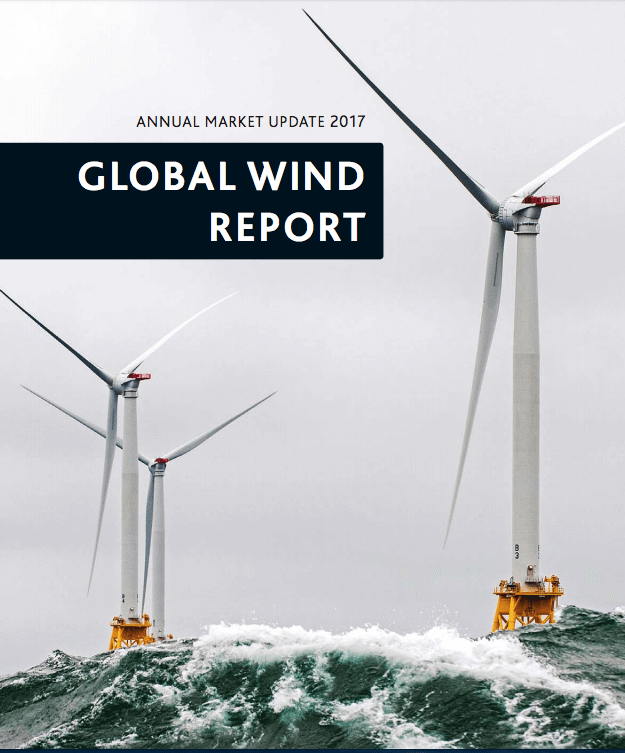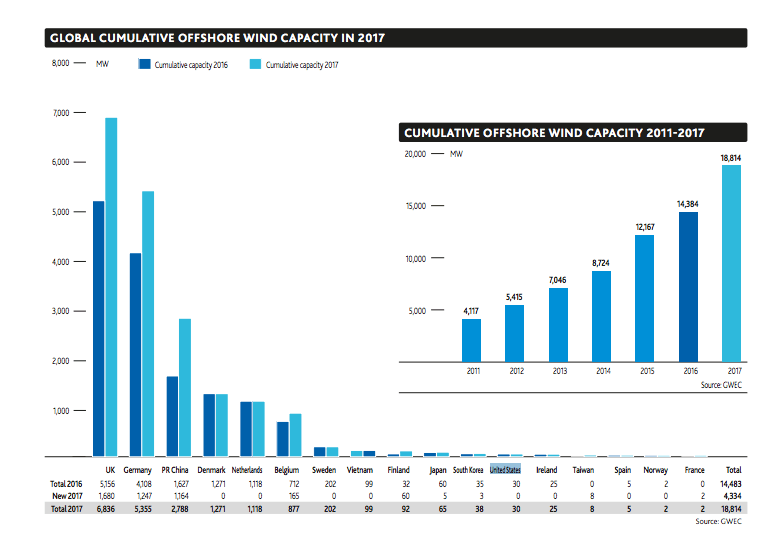The Global Wind Energy Council (GWEC) released its Global Wind Report: Annual Market Update, showing a maturing industry successfully competing in the marketplace, even against heavily subsidized traditional power generation technologies. More than 52 GW of clean, emissions-free wind power was added in 2017, bringing total installations to 539 GW globally.

Download the full report here.
With new records set in Europe, India and in the offshore sector, annual markets will resume rapid growth after 2018.
“Wind power is leading the charge in the transition away from fossil fuels; and continues to blow away the competition on price, performance and reliability,” said Steve Sawyer, GWEC Secretary General. “Both onshore and offshore, wind power is key to defining a sustainable energy future.”
Dramatic price reductions for both onshore and offshore wind continue to surprise. Markets in Morocco, India, Mexico, and Canada range in the area of U.S.$ 0.03/kWh, with a recent Mexican tender coming in with prices well below US$ 0.02/kWh. Meanwhile offshore wind had its first ‘subsidy-free’ bids in tenders In Germany and the Netherlands, with tenders for nearly 2 GW of new offshore wind capacity receiving no more than the wholesale price of electricity.
GWEC’s rolling five-year forecast puts the 2018 market at a similar level as 2017, as the dominant EU markets in Germany and the UK will face reductions due to changing regulatory environments, and India’s market will drop temporarily due to a ‘policy gap’ between the old and new systems; but the sector will return to dramatic growth in 2019, will pass the 60 GW milestone in 2020, and move upwards from there to reach a total of 840 GW by 2022.
“We have a booming new market in Argentina, a return to form in South Africa, Mexico on the verge of dramatic growth, and a powerhouse building in India,” said Sawyer. “We see huge potential just beginning to be realized in Russia, Vietnam and even Saudi Arabia; and offshore is spreading like wildfire across the globe due to Europe’s patient, pioneering efforts to bring the technology to cost-competitiveness.”

The U.S. market is projected to remain strong at least through 2020, and probably beyond, and Brazil will continue to dominate Latin American markets, although with a new challenger from Argentina. New markets continue to emerge in Africa and Asia, although China will continue to be the dominant market globally, but with less spectacular growth than in the past decade.
Wind penetration levels continue to increase rapidly. Denmark got 44% of its electricity from wind in 2017, and Uruguay more than 30%. In 2017, wind supplied 11.6% of the EU’s power, led by Denmark, Portugal and Ireland at 24% and Spain and Germany just under 20%. Four US states get more than 30% of their electricity from wind, as does the state of South Australia, and a number of states in Germany.
“Driven by the improving economics of wind power, as well as solar and storage, the outlines of a 100% renewable energy system are becoming clear,” added Sawyer.
Filed Under: News




